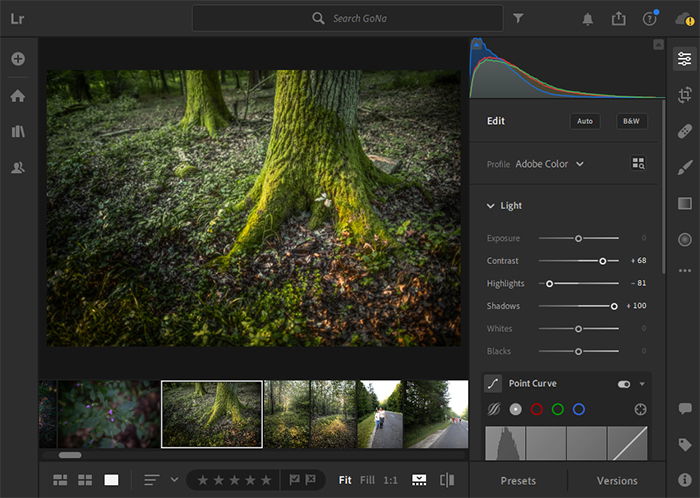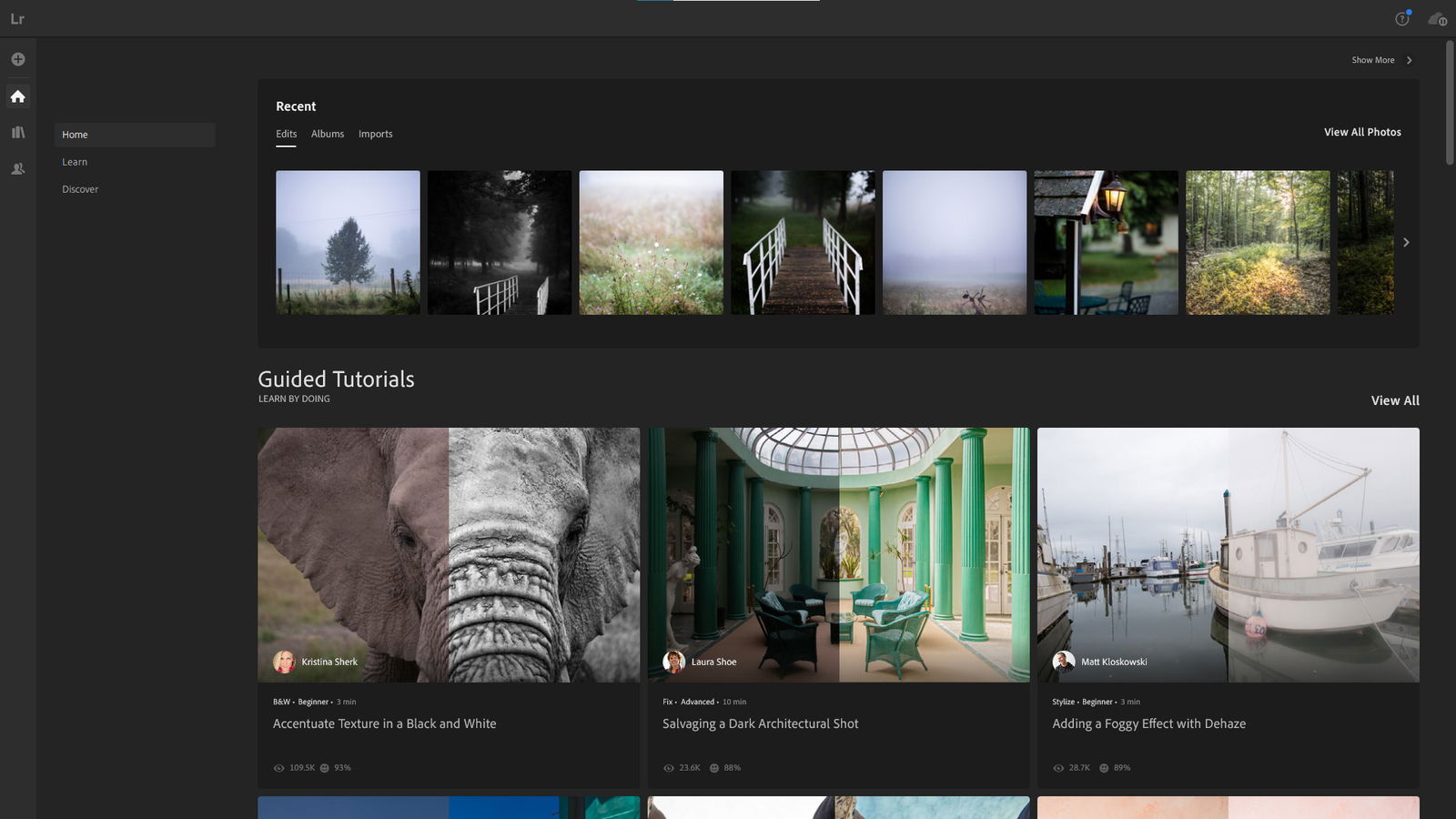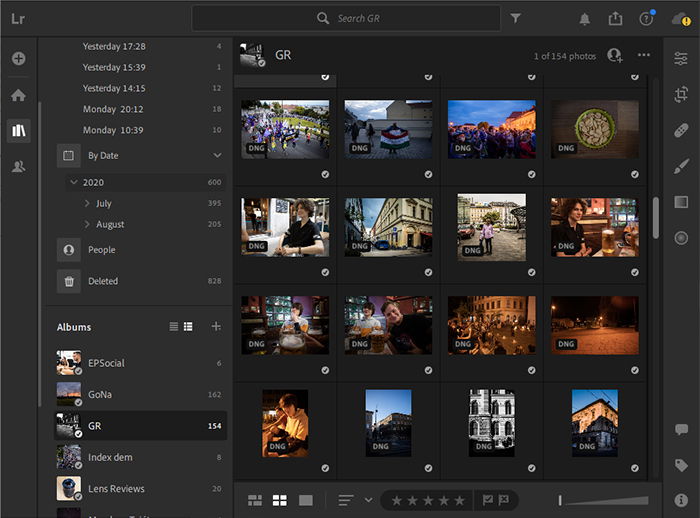Adobe Lightroom CC is a crucial part of the workflow for many photographers. It has a long history as a practical, feature-packed image processing and file management application.
But many photographers, like myself, like Lightroom Classic. Adobe has added more and more features throughout the years. But it’s fair to say that they have been reluctant to optimize the program.
The current version is quite hard to like (for me, at least). It has a cluttered and unresponsive interface. And it often has too many unnecessary features.
That’s one of the reasons why Adobe introduced Lightroom CC a few years ago. It is designed for the cloud era, primarily for enthusiasts.
It offers all the base features of Lightroom Classic in a more streamlined, lighter, and faster application. So let’s see if you should give it a try.

Overview of Adobe Lightroom CC
Lightroom CC was introduced in 2017 when Adobe decided to split up Lightroom into two separate applications.
Lightroom Classic has been kept as a photo processing and management workstation for use on desktop computers. Lightroom CC offers extensive mobile and tablet support (besides desktop).
It also has cloud sync and a brand-new interface with slightly limited functionality.
It’s important to note that you don’t have to choose between the two. Both are available in Adobe’s Photography Plan. And you can use them simultaneously.
As a hint to the verdict, I find Lightroom CC to be a great tool for managing and editing my off-work photography and smaller jobs. But it has limitations that make it difficult for professional use.

Who Is Adobe Lightroom CC For?
The target audience for Lightroom CC is fairly well definable. Anyone who doesn’t need extensive import and export tools and plugin compatibility has a high chance of being better off with CC.
It’s especially useful for photographers who shoot a lot on the run. So documentary or street photographers can edit on the go.
Cloud synchronization is a feature I didn’t really know I needed before starting to use CC. But I’ve been loving it ever since.
Price
Lightroom CC is available as part of various subscription packages by Adobe. The cheapest of these is the Photography Plan. This costs $10 per month in the US.
In the Photography Plan, there is 20 GB of cloud storage included and access to Photoshop. For an additional $10 per month, you get 1 TB of storage, which is plenty if you filter your images properly.
Compatibility
Lightroom CC is available on all platforms. It has desktop applications for Windows and Mac. And it has mobile and tablet applications for both Android and iOS.
Furthermore, it’s also available from your browser. Albeit, it’s quite sluggish there.
It’s not a hardware-intensive program, much less so than Lightroom Classic itself. This is because it was newly designed from scratch a little while ago.
Classic, on the other hand, has been around for more than two decades. And it was never entirely redesigned.
Key Features
Let’s go over the main software features of Lightroom CC.
Non-Destructive Workflow
Like most advanced photo editing software, Lightroom CC is non-destructive as well. This means that your original image files are kept unmodified throughout the editing process.
Changes made to images are saved separately—in the case of Lightroom CC to the cloud. You can revert to the original image or make a new edit at any point during editing.
Interface
The user interface of Lightroom CC is clean and responsive, in stark contrast to the Classic version. And it has three main segments—Home, Library, and Sharing.
Of these, I haven’t found much use for the Home panel. It’s just a summary of what you’ve edited recently.
And it also has tutorial videos and guided tours of the software. Sadly, there’s no way I’ve found to turn these off.
It seems like Lightroom CC is currently tailored more towards beginners, even though its functionality enables otherwise.
This is also apparent in the smartphone version, where three-quarters of the bottom bar is occupied by non-editing related functions.
The Library panel is where all the action happens. You’ll find your imported images here and your editing options. You can create albums and filters for better management.
The Sharing panel has all albums and images you’ve shared. And in terms of shortcuts, Lightroom CC is almost identical to Lightroom Classic.

Editing Tools
If you’re familiar with Lightroom Classic, the basic editing toolkit is very familiar. You have the same tools in a similar grouping, which are the following:
- Light (Exposure, Contrast, Highlights, Shadows, Whites, Blacks, Tone Curve)
- Color (Temperature, Tint, Vibrance, Saturation, HSL mixer with color picker)
- Effects (Texture, Clarity, Dehaze, Vignette, Grain, Split Toning without color picker)
- Detail (Sharpening, Noise Reduction, Color Noise Reduction, plus options for each)
- Optics (Chromatic Aberration and Defringe options, Lens Corrections, Geometry)
You can crop and rotate your images with the Crop tool. This tool allows you to set specific aspect ratios. But you can’t put in custom ratios.
The well-known local adjustments (Radial, Gradual, and Brush) are also available. And there are healing and cloning tools as well.
The Calibration menu is missing. But you can choose and import profiles. By default, Adobe’s own standardized color profiles are selected.
If you have a supported camera (basically any DSLR, mirrorless, or advanced point-and-shoot model), you can also choose a camera-matching profile. This is the same as choosing it in-camera.
A powerful feature that both Lightroom versions offer is presets. You can make your own or import presets (like ExpertPhotography’s). They can really speed up your editing process.
Lightroom has a dominant place in the editing software market. And this ensures there are thousands of presets and preset packs available, free or paid.
Management Tools
Here, Lightroom CC starts to significantly diverge from the Classic version. Whereas Classic allows you to create catalogs and stacks, there are no such things in CC.
Instead, everything is stored in the cloud, with an offline cache and the option to import offline only. You can create albums and filter for images based on date, camera model, rating, and more.
Lightroom CC also has a face-detection feature. (You need to enable it manually for privacy reasons.) And you can filter for faces too.

Smartphone App
One of the reasons I really like Lightroom CC for my personal use case is that it has a fully-fledged smartphone app. All the aforementioned tools and options are available from my phone.
I use it a lot for my street and event photography, primarily with my Ricoh GR III. But also with my DSLRs occasionally.
I copy the images from the camera onto my smartphone either via Wi-Fi or a card reader. Then I import the photos into Lightroom CC and start editing.
After a short while, I have an edit that is ready to be shared if I choose to. And the next time I open up Lightroom on my desktop, the image and its edits are there, in original quality!
The smartphone interface is a little bit cluttered. But that’s necessary to keep all the functionality of the desktop version available.
Browser Access and Sharing
Lightroom CC is available from your browser as well. To be fair, it’s slow (because of RAW file sizes). And it’s quite unresponsive. But it at least exists.
This can be very useful. Even if you don’t have any devices on hand, you can still access my library, make edits, and export. You can share images directly through the Lightroom CC web app.
You can create a web gallery out of any album you have in your library, which is ready to share. And you don’t need to export and re-upload to another sharing website.
Alternatives
As a multi-platform editing and photo management suite, Lightroom CC currently has no direct competition.
Lightroom Classic CC, the original version, is probably better for you if you’re working with huge catalogs. It’s more adept if you need more extensive batching, filtering, and importing options.
Our Verdict
Lightroom CC is an excellent application with a few non-fatal flaws. I’d love it if it was slightly more customizable. (Allow you to remove tutorials, for instance).
But overall, this application is an excellent choice for a large audience of photographers. It surpasses Lightroom Classic in practicality for many use cases.
Check out Lightroom subscription options on Adobe’s website. And learn all the secrets of editing in Lightroom with our Effortless Editing course!


